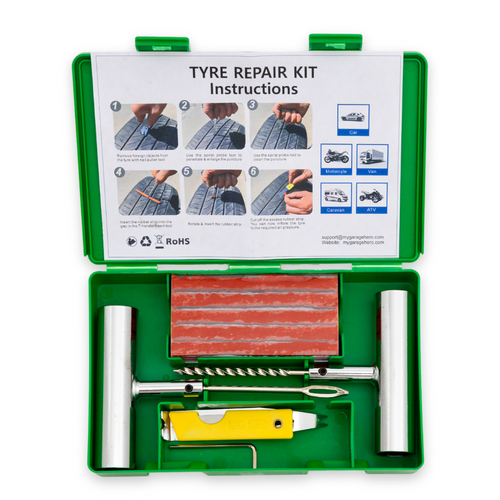Introduction
You slide into your car, already running late. You turn the key and hear it: click -click -click -click. That sickening, rapid‑fire clicking that means your battery is dead—or worse, complete silence. No dashboard lights. No radio. Nothing.
Your stomach drops. You're stranded. Maybe it's a dark parking garage. Maybe it's a deserted road. Maybe you left your headlights on, or maybe your battery just decided today was the day to quit. It doesn't matter why it happened—what matters is that you're stuck, and that familiar wave of helplessness starts to set in.
But here's the truth: you don't have to feel helpless. You don't need to wait for a tow truck, flag down a stranger with jumper cables, or hope someone from roadside assistance shows up in the next hour. With a portable jump starter in your trunk and the knowledge in this guide, you can be back on the road in less than five minutes—safely, confidently, and on your own terms.
Why You Should Carry a Portable Jump Starter
Think of a portable jump starter as your own roadside insurance policy. It empowers you to solve a dead battery situation without calling for help. Here’s why owning one is a must:
- You don't need help: no flagging down strangers or waiting for a friend.
- It's faster: connect, start, disconnect—often in under five minutes.
- It's safer: modern jump starters have built‑in safety features like reverse‑polarity protection and spark‑proof technology.
- It's versatile: many models double as USB power banks, LED flashlights or even air compressors.
Types of portable jump starters:
- Lithium‑ion: lightweight, compact, holds a charge longer and delivers multiple jumps per charge—great for most passenger vehicles.
- Lead‑acid: heavier, bulkier, less expensive but suited for larger vehicles that need more cranking power.
If you drive, you should own one. Period. It’s not a luxury—it’s essential roadside preparedness.
The Critical Question: How Many Amps Does Your Jump Starter Need?
Amperage tells you how much power the jump starter can deliver to crank your engine. For small cars and motorcycles, 400‑600 peak amps are usually sufficient. Mid‑size sedans and SUVs often require 600‑1000 amps. Larger trucks or diesels might need 1000 amps or more. When in doubt, choose a model with a higher peak amp rating—there’s no harm in having extra reserve, but a unit that’s too weak won’t start the vehicle at all.
Also pay attention to “cranking amps” (CA) or “cold cranking amps” (CCA); higher CCA ratings indicate better performance in cold conditions. Many jump starters list both peak amps and CCA—match the CCA to your vehicle’s battery requirements for reliable starts in winter.
How to Use a Portable Jump Starter (Step‑by‑Step)
Connecting a jump starter safely is straightforward, but you must follow the right order to prevent damage or injury. Here are the steps:
- Ensure the jump starter is fully charged. Keep it stored with at least 75% capacity.
- Switch off all accessories in your car (lights, radio, etc.).
- Connect the red positive clamp to the positive (+) terminal of the dead battery.
- Connect the black negative clamp to a solid, unpainted metal part of the engine bay (not directly on the negative battery post). This helps prevent sparks near the battery.
- Turn on the portable jump starter.
- Attempt to start the engine. If it doesn’t crank immediately, wait one minute before trying again. Do not crank for more than 5–10 seconds at a time.
- Once the engine starts, turn off the jump starter and disconnect the clamps in reverse order—black clamp first, then red clamp.
- Let the engine idle for a few minutes to recharge the battery. Recharge your jump starter as soon as possible so it’s ready for next time.
For a visual demonstration of safe clamp connection, check the embedded video below. It shows how to identify the terminals and connect the clamps correctly.
Common Mistakes to Avoid
- Reversing the clamps: always match red to positive and black to ground; reversing them can cause sparks or damage sensitive electronics.
- Using a low‑charge jump starter: if your unit is under‑charged, it may not deliver sufficient amperage to start the engine.
- Clamping onto corroded terminals: dirty battery posts reduce conductivity. Clean the terminals with a wire brush before attaching clamps.
- Trying to jump a faulty battery repeatedly: if the car doesn’t start after a few attempts, the battery or electrical system might be damaged. Seek professional help.
Maintenance and Extras
Portable jump starters are low‑maintenance, but you should recharge them every three to six months (or after each use). Store them at room temperature and check for physical damage or swelling of the battery. Some models include built‑in tyre inflators and USB power banks, making them versatile emergency tools.
If your battery goes flat frequently, invest in a quality battery charger to maintain your car battery’s health over time. Unlike jump starters, chargers provide a slow, steady charge that fully replenishes the battery, which helps prevent sulfation and extends battery life.
Stay Prepared
A portable jump starter is one of the simplest and most effective pieces of kit you can keep in your vehicle. Combined with a tyre repair kit and other on‑the‑go vehicle accessories, it keeps you independent and ready for unexpected breakdowns. For more tips, guides, and product recommendations, explore our blog. If you need quality parts or professional advice, check out the trusted resources at Repco, Battery World and WhichCar 4x4 Australia—they have a wealth of independent information for car enthusiasts.
Stay safe, stay prepared, and happy driving!


